Este post também está disponível em:
Português
English
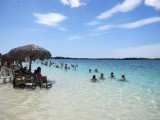
The west coast of Ceará, which stretches from Tabuba to the border with Piauí, alternates stretches of beaches not frequented by tourists, such as Bitupitá, with one of the most popular destinations in the Northeast, Jericoacoara beach.
The beaches and villages of the coast West of Ceará have in common the hospitality with which the visitor is received and the preservation of a traditional culture, linked of course to the sea.
The dunes and the winds play important roles here: an example is what happened to the village of Tatajuba, literally swallowed by the movements of a dune and transferred to Nova Tatajuba.
See the map of the West coast of Ceará
From Fortaleza, the best way to reach the west coast of Ceará – called the Costa do Sol Poente – is by the highway that bears the name Estruturante.
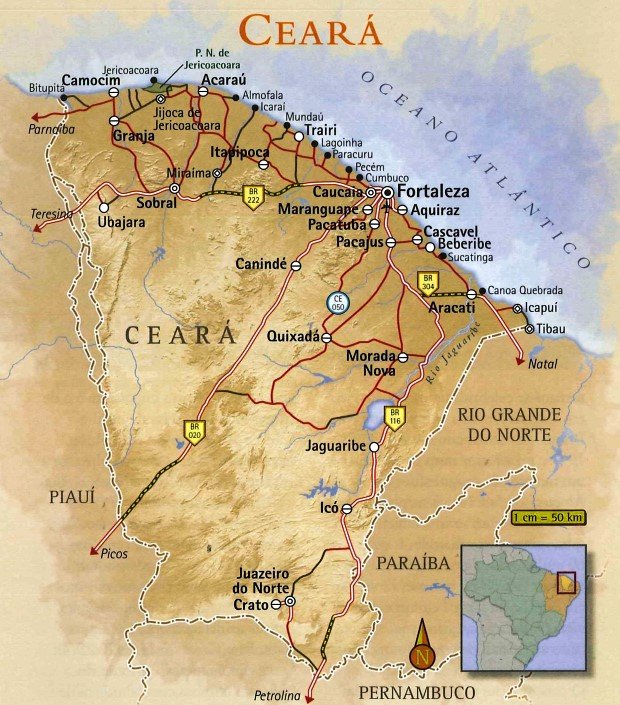
Main cities and beaches of the West Coast of Ceará
See the map of the beaches of the West Coast of Ceará


Praia do Preá no Ceará

Jericoacoara no Ceará

Camocim no Ceará

Rota das emoções no Ceará

Mundaú no Ceará
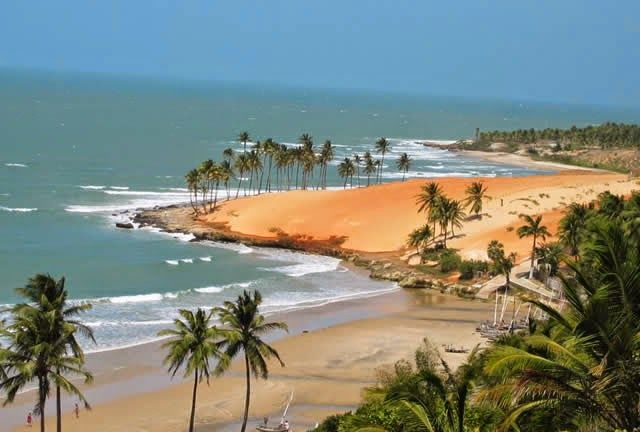
10 pontos turisticos mais visitados de Caucaia
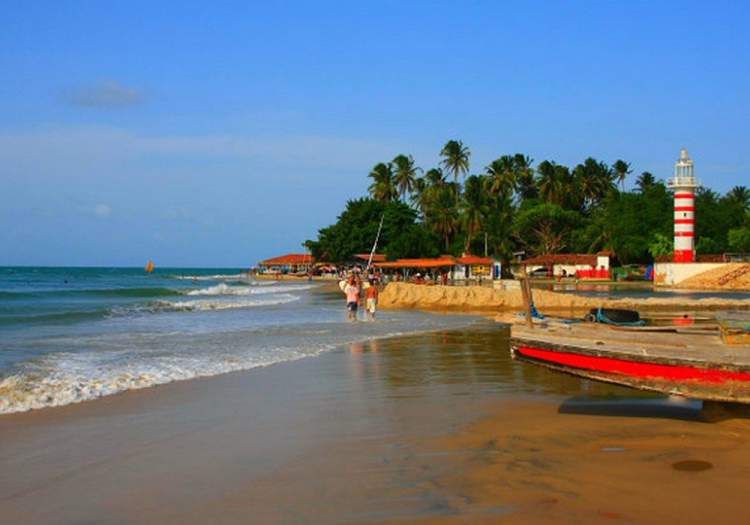
Paracuru no Ceará01:57
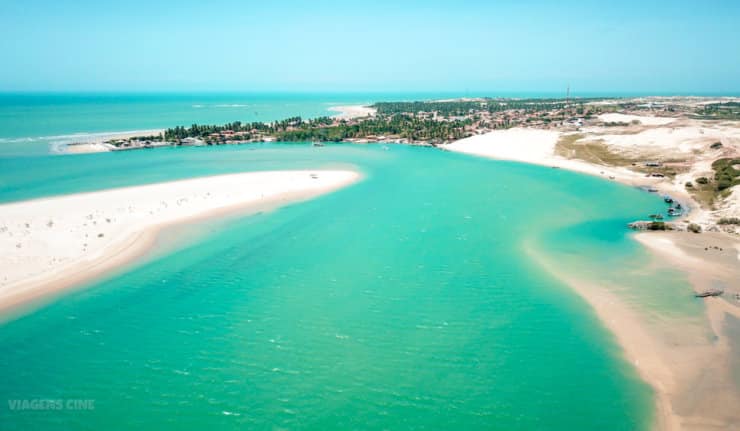
Praia de Flecheiras, Praia de Mundaú e Praia de Guajiru05:03
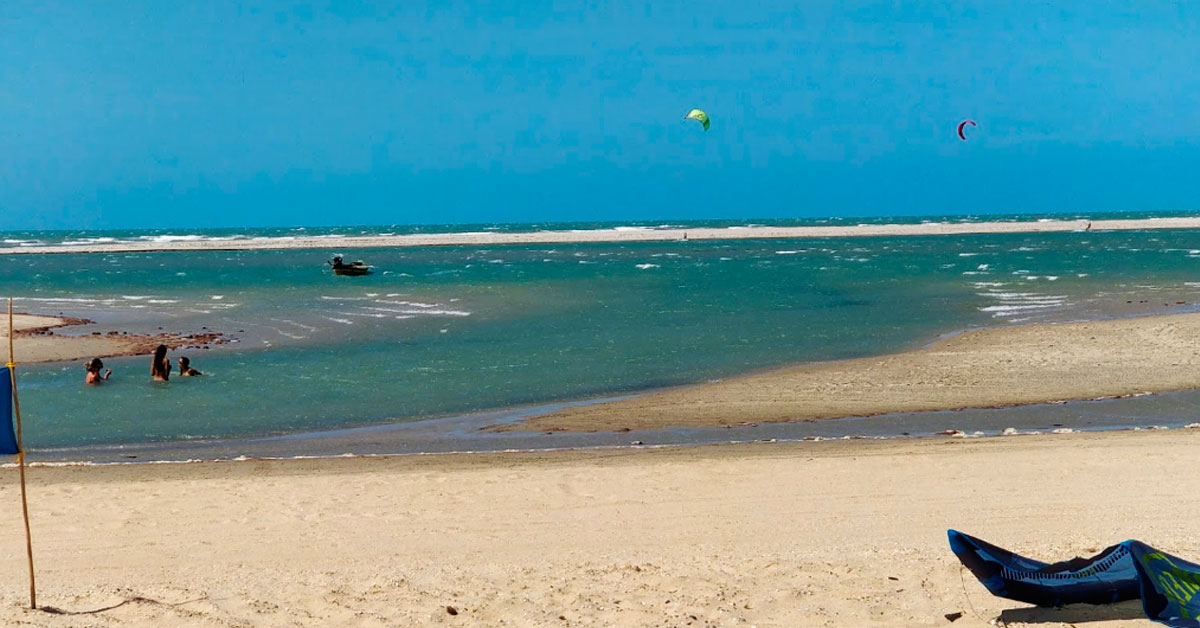
Lagoa de Tatajuba em Camocim03:13
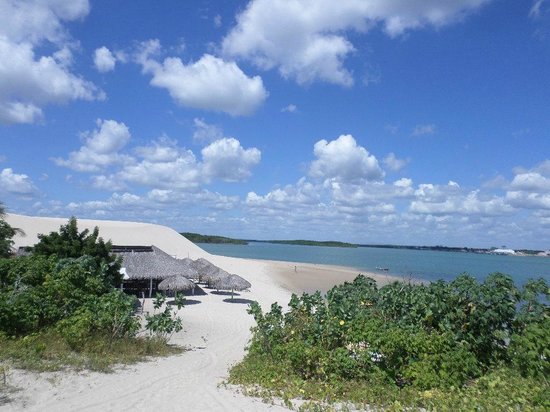
Ilha do Amor em Camocim05:11
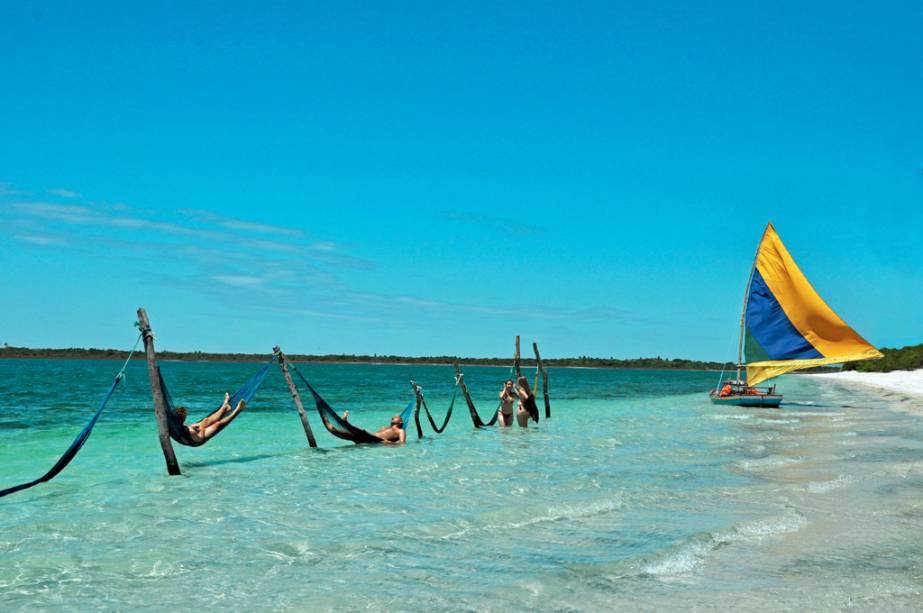
Praia de Jericoacoara no Ceará
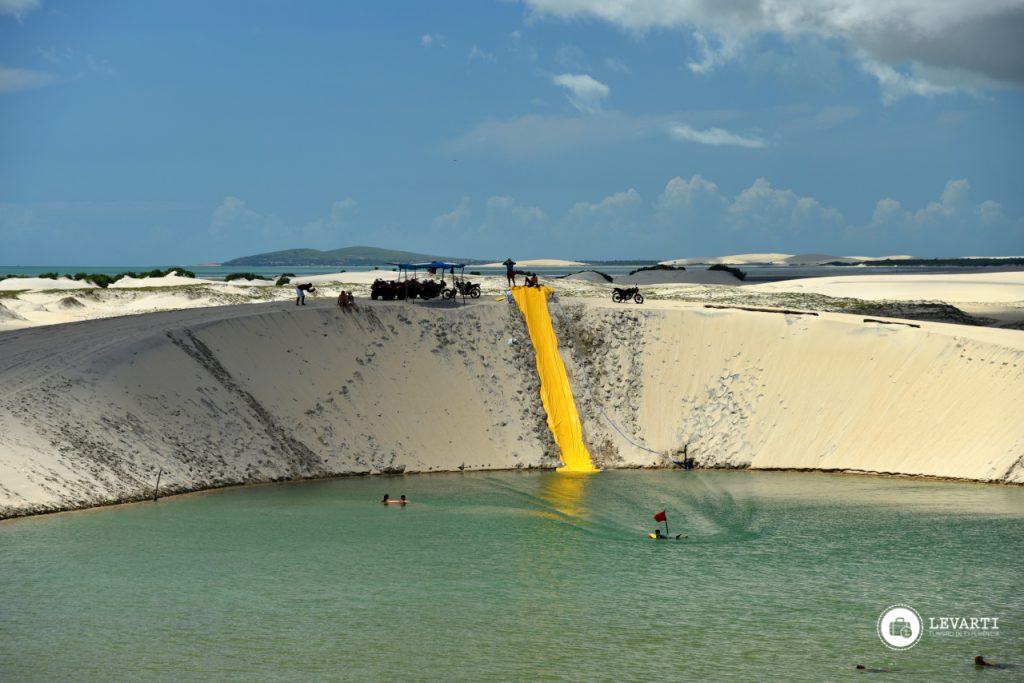
Drone - Praia de Jericoacoara no Ceará
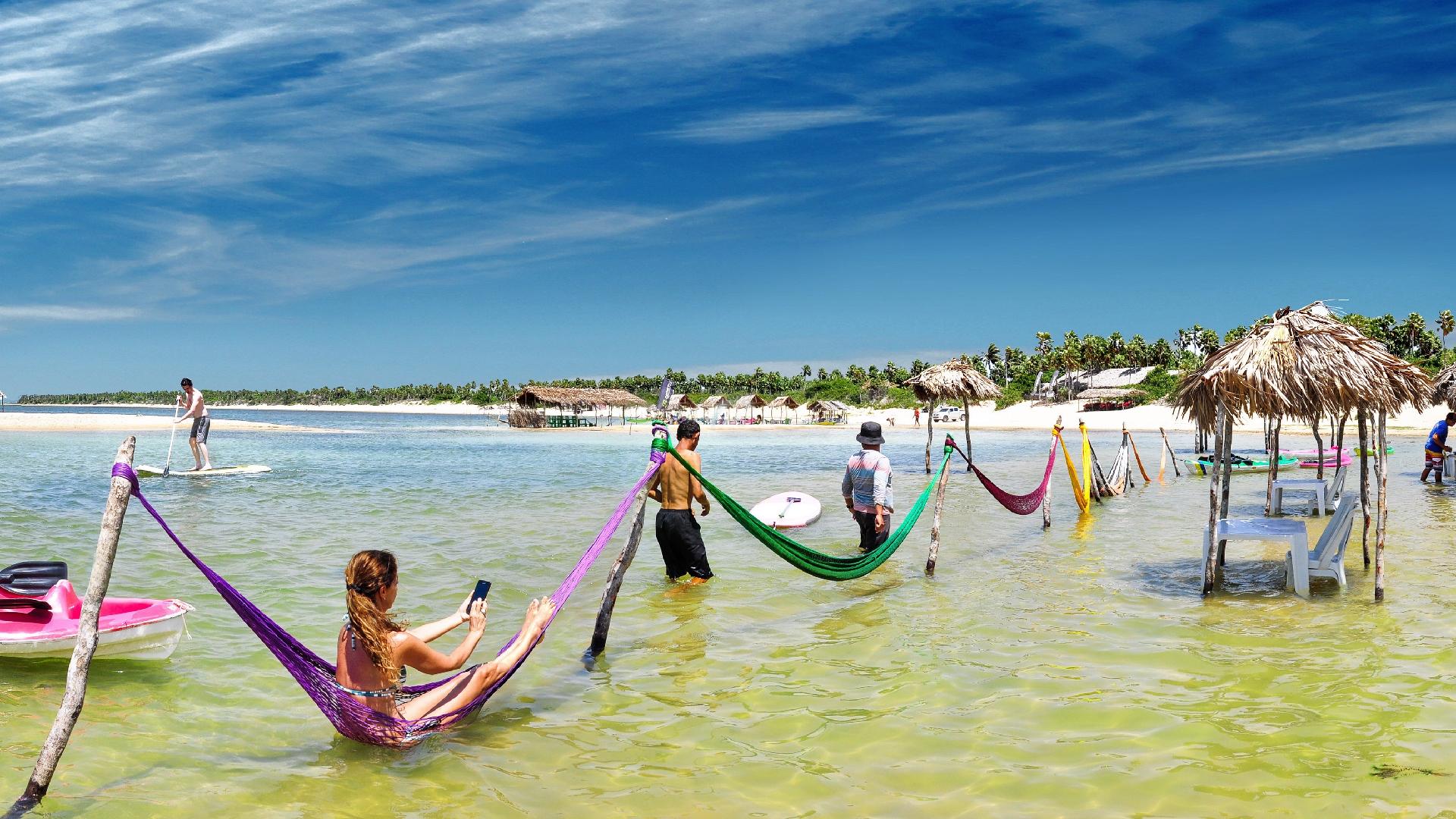
10 Dicas sobre Jericoacoara no Ceará02:49
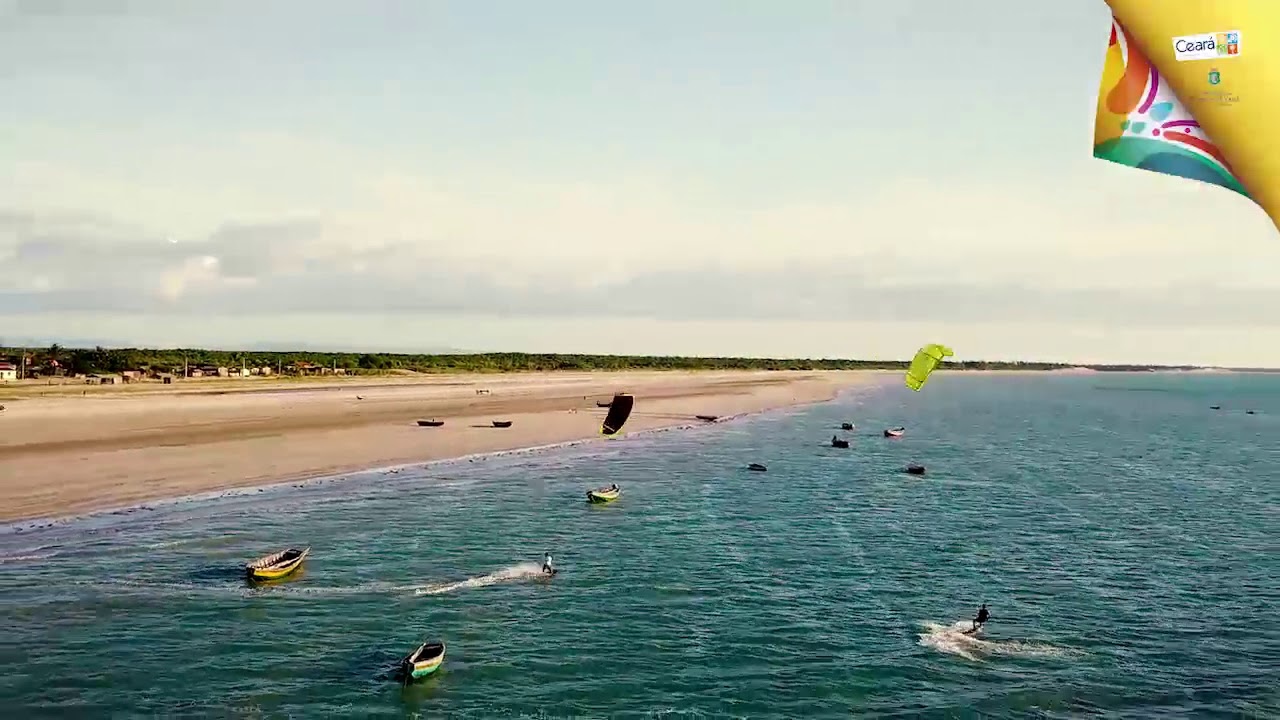
Praia de Bitupita no Ceará
1. City of Caucaia
Caucaia is part of the Metropolitan Region of Fortaleza, and currently presents itself as one of the main tourist centers of Ceará, having the second largest tourist flow in the state, due to the polarizing influence of the metropolis Fortaleza and praia do Cumbuco.
The Coastal Region of Caucaia covers the beaches of Iparana, Pacheco, Icaraí, Tabuba and Cumbuco.
The municipality is the main stage for sailing sports, especially kitesurfing.
Cumbuco is the main tourist destination of Caucaia. The locality is known worldwide for its natural landscape with lagoons, rivers, dunes and for the practice of water sports such as kitesurfing, and surfing.
Cumbuco also stands out for being the only area to have all types of accommodation in Caucaia, including an international flag resort of Portuguese origin.
It benefits from its proximity to the metropolis Fortaleza.
Caucaia has 44 km of coastline, of which 28 km are part of the coastal localities of Caucaia-Sede and the remaining 16 km belong to the district of Guararu and Catuana, inserted in the Environmental Protection Area of Rio Cauípe and Pecém Ecological Station.
Its beaches are among the most frequented, either for its mild and clear waters of the South Atlantic, or for its fixed and mobile sand dunes, its coconut groves, mangroves and natural lagoons that make this place a paradise of indescribable beauty.
Caucaia beaches: refuges in the midst of nature
Very popular with those who practice extreme sports, the city welcomes fans of windsurfing, dune rides, jet skis, kayaks and banana boats. Especially at Praia do Cumbuco and Lagoa do Banana, sports tourism and other adventure attractions are found in abundance, with trails and various tours.
In most of its beaches, coconut trees and dunes are present, as in Cumbuco Beach, one of the most frequented in the city. Among other beaches stand out:
- Icaraí Beach: famous for its carnival and for hosting several surfing championships.
- Barra do Cauípe Beach: very popular for kitesurfing and buggy rides. Take the opportunity to visit the Cauípe Lagoon.
- Barra Nova Beach: ideal destination for families in search of calm waters – the sea looks like a lagoon so calm!
- Pico das Almas: another perfect spot for surfers and those looking for more contact with nature. The lack of infrastructure is rewarded by the scenery of rustic beauty.
- Tabuba Beach: At the mouth of the Sapucaí River, there are natural pools and bars by the sea.
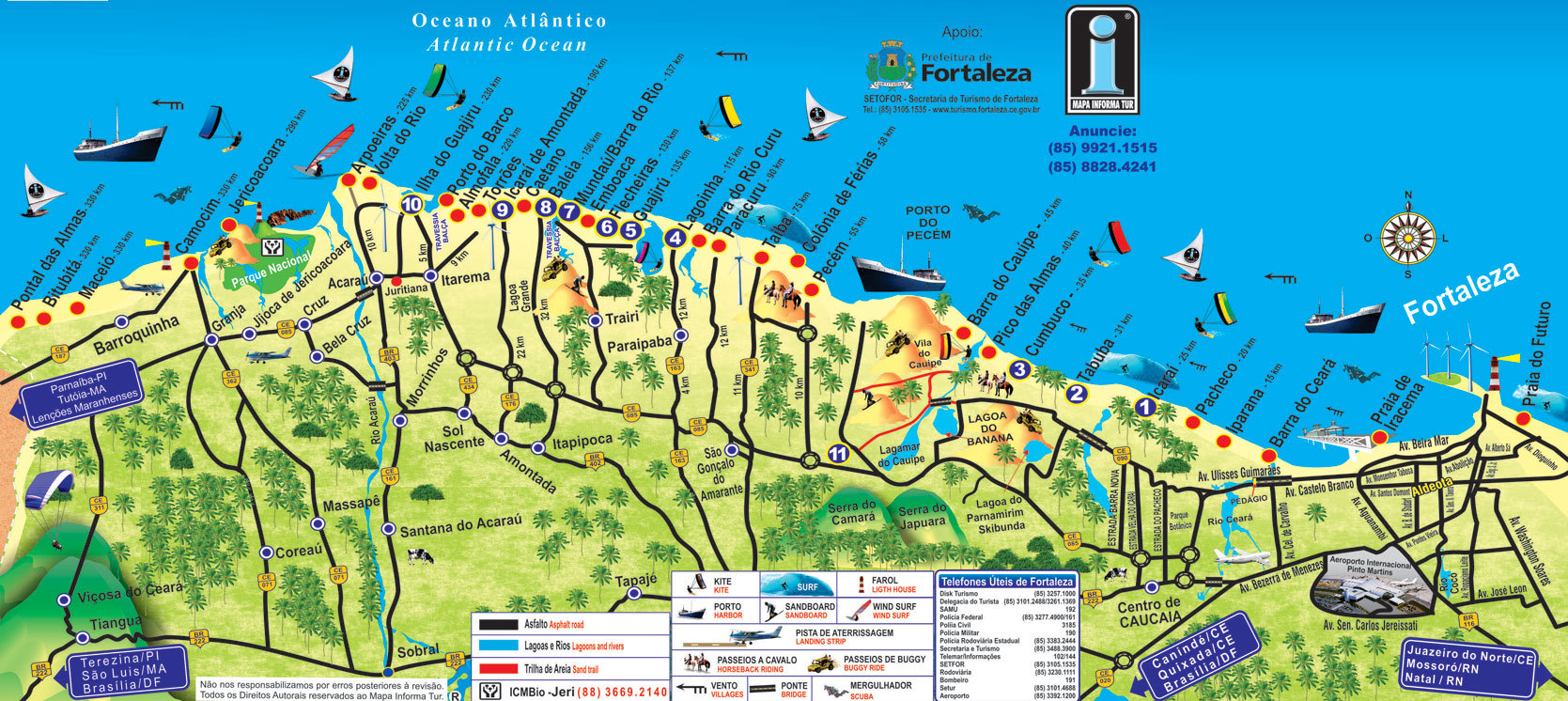
See Cumbuco beach in Ceará is a kitesurfing paradise.
2. City of São Gonçalo do Amarante
Also known as Praça da Matriz in honor of the Church of São Gonçalo do Amarante, the patron saint of the city.
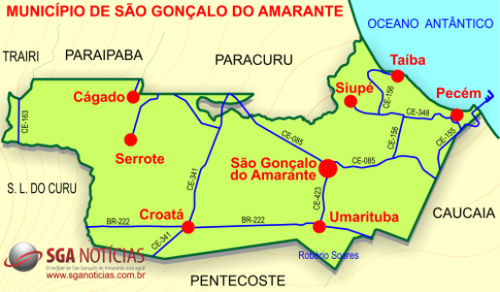
Everything revolves around the square, here lovers meet to date, retirees gather for a chat, the faithful go to strengthen their ties with religion, children to play, teenagers to snack and adults to have a beer.
The square also has: lighted fountain, stools, kiosks, snack bars, internet, parking, toys, etc. We can say that it is in the square where everything happens.
Taiba Beach
An old fishing village that has become a great tourist potential, due to its numerous natural beauties. It has hospitable people, who are always available to receive their visitors with great friendliness and joy, typical characteristics of the place.
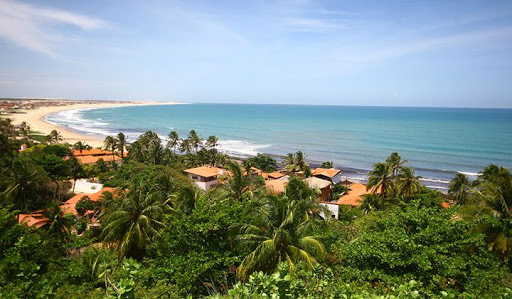
The sea is ideal for water sports such as surfing, windsurfing and bodyboarding. The nights are festive with the heated forró, pagode and samba no pé. Along the beach, there are stalls with good snacks including crab, fried fish, shrimp and lobster.
But the biggest gastronomic sensation in the region is the Escargot Festival, which is held every August.
The delicious and sophisticated food arouses the curiosity of thousands of tourists from Brazil and the world, generating more work and income for the district, which already has 27 farms.
The view shown is of a game of hues that seduces by the blue sea, the golden of the sun, the beach with sands here and there enverdecidas by the coconut trees.
This is Taíba. A beach of neighbors gathered for a pleasant chat. This is certainly an ideal place to visit in Ceará.
Praia do Pecém
Praia do Pecém is located between the beaches of Cumbuco and Paracuru.

It is located 58 km from Fortaleza, in the municipality of São Gonçalo do Amarante, which has as access the Costa do Sol Poente Highway, better known as CE-085, which is in excellent traffic conditions.
Pecém is home to beautiful tourist scenery, which consists of coves and natural pools of salt water and also of coconut trees, rafts and white dunes, contrasting with the green of the sea waters.
With inviting waves, it is an excellent place for surfing.
3. City of Paracuru
Paracuru is 88 km from Fortaleza, the place has about 20 km of coastal strip with a great diversity of landscapes.
Starting with the beach of the Farol, the main one of the municipality and busiest for being the closest to the Matriz square.
When the tide is low, the Pedra Rachada becomes a postcard due to the natural pools.
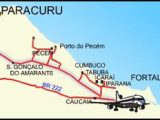
For those looking for more excitement, the Praia do Quebra Mar is ideal.
With winds that can reach up to 40 km per hour, the place presents perfect conditions for kitesurfing and windsurfing.
The Paracuru beach also stands out for having great conditions for surfing.
At dusk, the view becomes even more beautiful. The sunset deserves to be seen from the highest point of the dune of the <nbsp;Praia das Almas.><nbsp;The place is almost untouched and the visual<nbsp;stunning.
Munguba Beach
Munguba Beach – busy urban beach of Paracuru with fishing corrals.
Ronco do Mar Beach
Ronco do Mar is a favorite spot for surfers and young people, with a concentration of tents. It is also known as Igreja Velha beach.
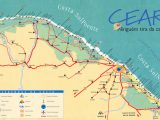
Pedra Rachada
Beach located in a small cove with coconut trees, reefs and natural pools. There are fish corrals in the sea and structure of tents on the beach.
Praia da Bica
At Praia da Bica visitors often come from neighboring beaches to bathe in the freshwater spouts of this beach, which is a port of anchorage for boats.
Lagoinha
Well-defined cove with a red dune full of coconut palms. At high tide the waves hit the rocks. It gets crowded in high season and during weekends.
4. City of Trairi
Trairi is situated on the coastal strip of the state, west of Fortaleza.
The Praia de Flecheiras is the great attraction of the city. In this place, the tourist will find the natural pools that are formed by coral reefs, during the period of low tide.
In Trairi, the visitor enjoys good inns by the sea, having the opportunity to take long and invigorating walks against the backdrop of the grandeur of our sea.
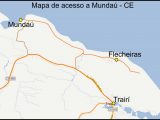
The tourist who spends his vacation in this city of Ceará returns with renewed energy.
Those looking for fun and excitement can also enjoy some options offered by Flexeiras.
Bars, restaurants and concert halls animate every night. Festivals and sports championships are also held constantly.
Tourists can climb the dunes to enjoy the view and visit small and large lagoons in the middle of the sand. Trairi has a lot of fun, joy, good food and parties.
Another tourist spot is the Mundaú Beach. In this place, there is the meeting of rare beauties: the river, the sea, the dunes and the coconut trees.
A boat trip on the river is a good way to get to know the beauties of the place; those who prefer can drive around and contemplate the lagoons and the vegetation that accompanies the coast.
It is also recommended to visit the Praia de Guajiru. On this beach you will find white sand dunes with inter-dune lagoons and a wide strip of sand framed by coconut groves.
At low tide, tourists and locals enjoy a delicious swim in the natural pools.
Embuaca Beach
Fishing village that preserves mud houses built next to the dunes and coconut trees. The sea has a dark color due to the waters of the Mundaú River.
Guajiru Beach
Quiet beach framed by coconut trees, with calm sea and natural pools.
Praia das Flecheiras
Beach with a wide strip of beaten sand, with tents, inns and hotels. It is suitable for swimming.
Mundaú Beach
The sea, near the Mundaú River, has dark waters. On the shore, there are inns. coconut trees and strip of beaten sand.
5. City of Camocim
The city of Camocim is 365 kilometers from the capital Fortaleza and has a famous neighbor, the village of Jericoacoara.
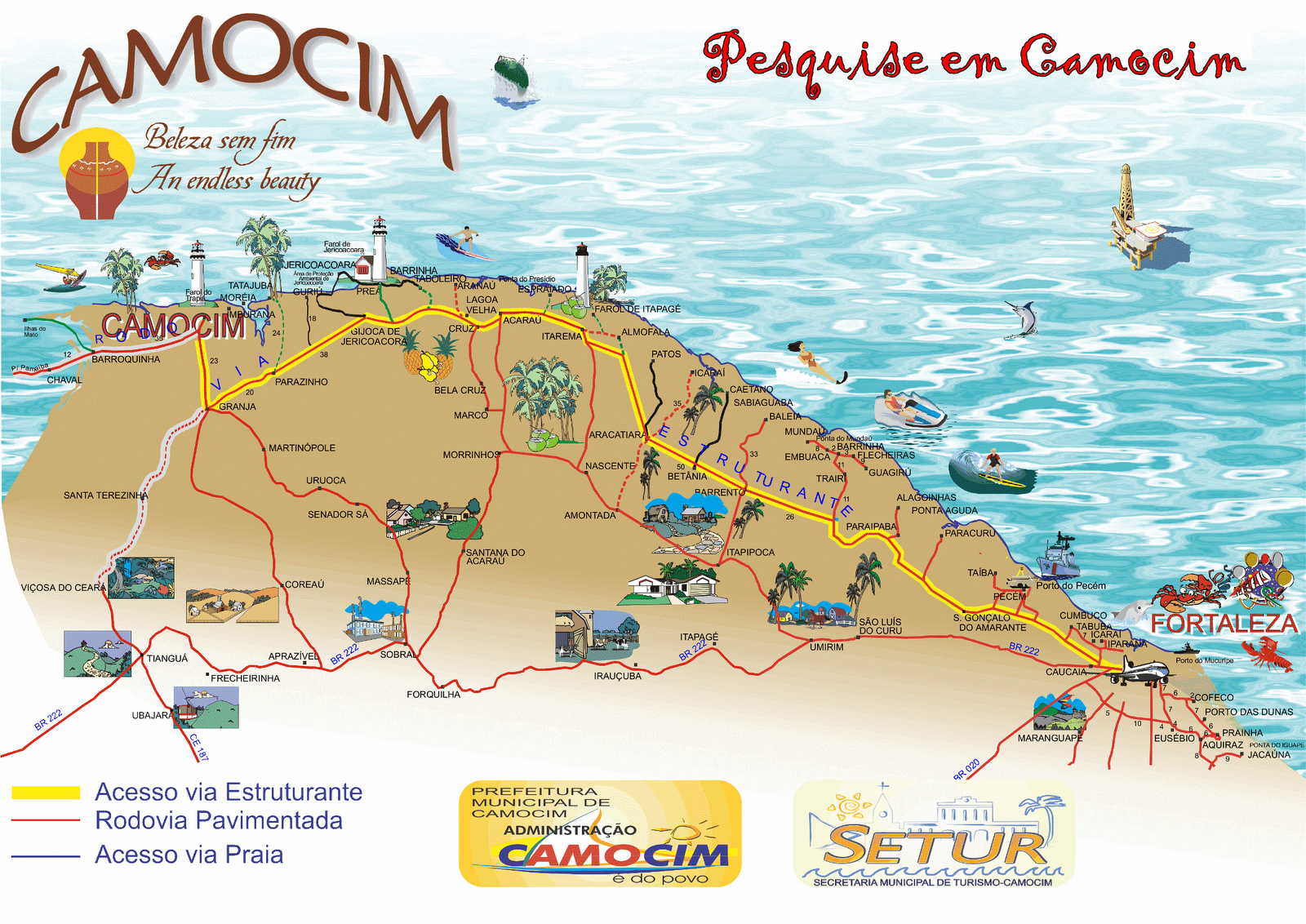
It is located near the border with the state of Piauí, being one of the last municipalities of the western part of the coast of Ceará.
In Camocim the tourist has nothing to complain about: there are 62 kilometers of beautiful beaches, some deserted, most with good infrastructure and all with wonderful landscapes. By the way, this is the great attraction of Camocim, its natural beauty.
The traditional colorful canoes, used in fishing, are all over the coast, composing the typical scenery of this region of the northeast. A curiosity: they are so dear and important to the population that they were listed as National Historical and Artistic Heritage by IPHAN.
The tourist infrastructure in Camocim is adequate, with a good offer of inns, hotels, restaurants, which can handle the crowds that arrive, mainly, during carnival, new year and the micareta in October.
Tourism agencies are prepared to carry out various types of tours in Camocim and region.
Those who enjoy ecological tourism and water sports such as kitesurfing and windsurfing will be delighted. The main form of transportation between the beaches is by buggy rental, or four-wheel drive vehicle.
Among the main attractions, the Coreaú River Estuary stands out. It is worth going through the mangroves and islets formed at the end of the Coreaú River.
Daily boat trips cover about 20 kilometers and along the way it is possible to see many birds, the interesting salt pans and many dunes.
The delicious bath in the fresh waters of the river makes the joy of tourists at the stop during the tour. A refreshment for the hot climate of the region.
The beaches of Camocim are beautiful and deserve to be known calmly.
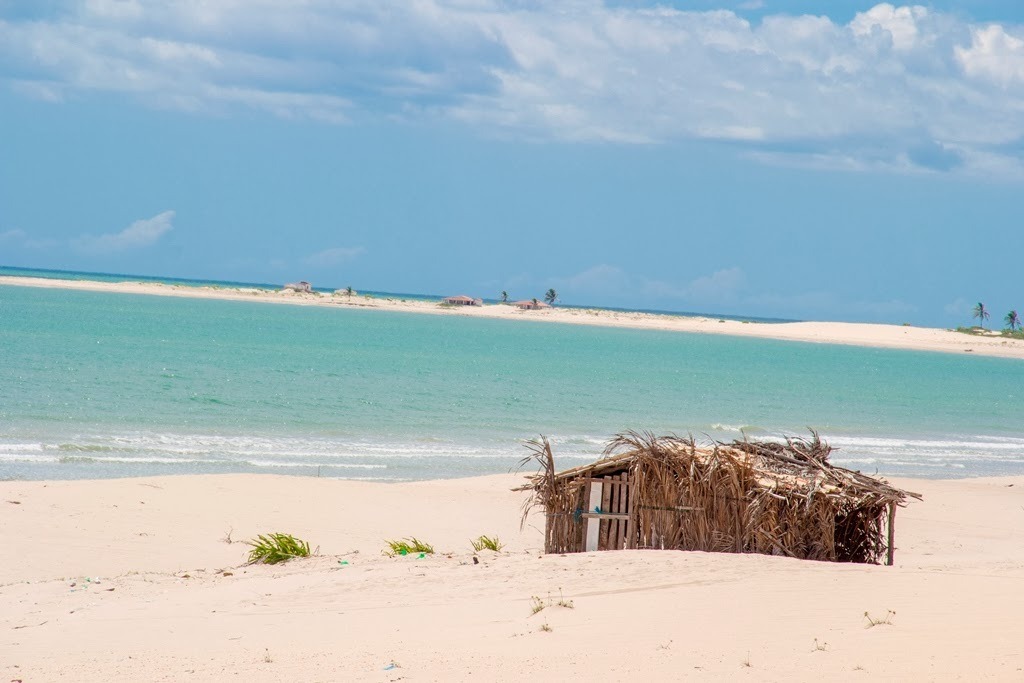
The Maceió Beach is busy during Carnival, when more than 10,000 tourists pass by, crowding the tents, bars and restaurants.
Throughout the year, the demand is for peace and quiet, in addition to the calm and warm waters.
The strong wind also attracts practitioners of extreme sports such as kitesurfing and windsurfing.
15 kilometers from the center of Camocim, the Maceió Beach is located in a fishing village with good infrastructure of inns and summer houses.
Already the Praia da Tatajuba is one of the biggest attractions of the region, located between Jericoacoara and Camocim.
It is impossible not to be enchanted by this true postcard of Ceará, formed by white dunes, the blue sea, coconut trees and the Lagoa da Torta, where the request is to swing in the submerged hammocks.
In addition to beauty, the place shows the strength of a people who had to face nature to get back on their feet.
The constant wind pushed the sands of the dunes that covered the village over the years. The little more than 700 residents rebuilt the town.
Adventure is part of the package, after all, you can only reach Tatajuba beach by boat, buggy or four-wheel drive vehicle.
Kite and windsurfers love this place. It is integrated into an Environmental Protection Area and so the scenery is stunning.
The Barrinha Beach is a quiet fishing village, perfect place to rest. Rent a buggy and enjoy the white and red areas of this beach.

The immense coconut grove adds to the beauty. A little further on is Xavier Beach, considered one of the most beautiful in the region and practically deserted.
As well as the Barra dos Remédios Beach, meeting point of the Rio dos Remédios with the Atlantic Ocean, which is one of the last deserted beaches in the state.
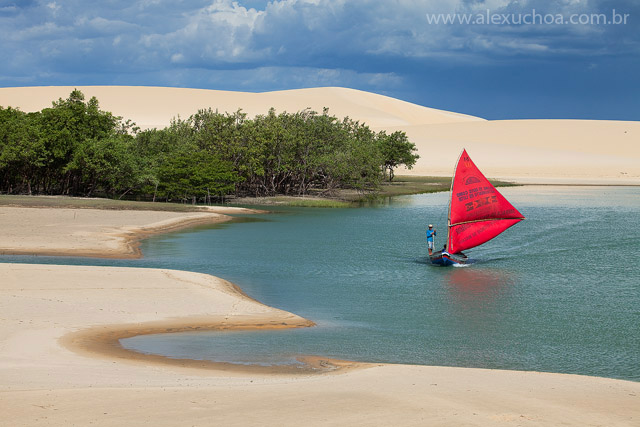
Just 3 kilometers from the center of Camocim, is Praia das Barreiras, which houses imposing cliffs, from where you have an incredible panoramic view.
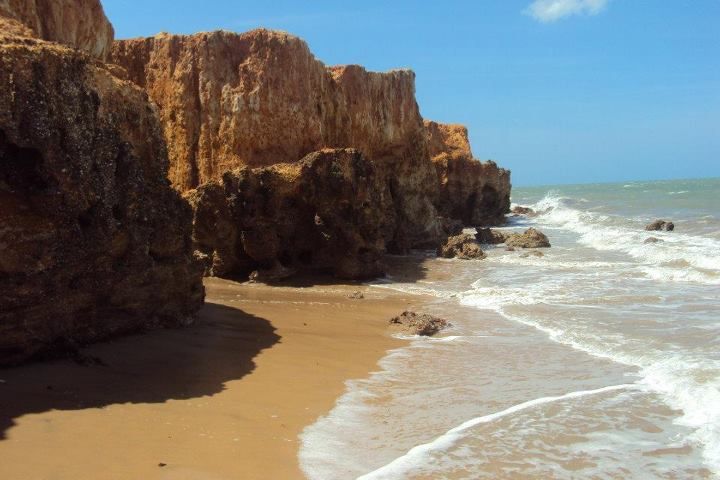
From the top the visitor contemplates the open sea, much of the city, the dunes of Ilha do Amor and the mangroves of the Coreaú River, where it is located.
Finishing the section of beaches, the Farol do Trapiá is accessible through the Praia das Barreiras and its cliffs.
Very quiet, it is very popular for bathing and has good infrastructure and typical cuisine restaurants.
To get to another must-see attraction in Camocim, the Ilha da Testa Branca, also known as Ilha do Amor, just cross the Coreaú River by ferry to enjoy this paradisiacal village.
From there you have a beautiful view of the city and its beaches. Those who go to the island can bathe in the sea, taste fresh crabs in the restaurants and even practice skiing in the dune areas.
Buggy ride
The most enchanting tour of the west coast of Ceará is Camocim, which can take all day – or not, if the traveler prefers a shorter and less tiring version. After the river with the ferry (the crossing takes about five minutes), you arrive at the island of Love, where the homonymous beach is located – a long, straight stretch of beaten sand, without major attractions.
The route becomes more interesting when the buggy crosses the mangroves that surround Moréia beach, where they begin to circulate between dunes and lagoons.
One of the stops is at the Funil dune, actually a set of huge dunes behind which lies the pleasant Verde lagoon.
From there the buggies go to the foot of the Encantada dune, along the beautiful Tatajuba beach, to the Torta lagoon, good for swimming and with a structure of stalls for lunch.
The visitor can stay there, waiting for the sunset in the beautiful Encantada, or extend the tour by going to Guriú, a village on the banks of the river of the same name.
The marvelous landscape of the river bar is one of the best known postcards of Jericoacoara, although officially the place belongs to Camocim.
The landscape is indeed breathtaking: the river flows into the sea, interspersing stretches of water and sand, forming pools of warm fresh and salt water.
Those who want to make the tour even more tender can take the ferry in Guriú and reach Jijoca de Jericoacoara.
Nova Tatajuba
A small fishing village, Nova Tatajuba is 32 kilometers from Jericoacora and belongs to the municipality of Camocim.
It was built in the 1980s, after the old village – Velha Tatajuba, as everyone calls it – was covered by the dunes, in a slow and relentless process that began in the 1960s until it expelled all the inhabitants of the village.
Today, when you ride a buggy up the dune, you can see the roof of the tallest buildings and the village chapel.
In Nova Tatajuba there is no electricity, the houses are made of mud, and the only cars that circulate through the streets are buggies carrying tourists from Jericoacoara and Camocim.
The landscape is composed of coconut trees, clear sands and high dunes.
The most beautiful is the Encantada dune, which is over 30 meters high and is the reference point for fishermen when they arrive from the sea.
Surrounded by legends – it is said that under it there is an old ship and that the voices of the crew can still be heard on silent nights – the Encantada dune offers one of the most beautiful views in the whole region.
Maceió Beach
Beach with weak waves, located between mobile dunes. It has two lakes, Cangalha and Boqueirão, and tents.
Nova Tatajuba
Small and quiet village, with coconut beach, clear sand and mobile dunes that can reach up to 50 meters high.
In the rainy season, lagoons form between the dunes.
Bitupitá
Beach with fish corrals, strong waves and wide strip of sand. It is home to a fishing community.
Cumbuco
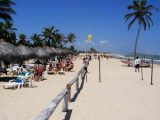
At 30 kilometers from Fortaleza, Cumbuco is an ideal destination for those who want to make a day trip from the capital of Ceará.
It offers from a quiet raft ride to a radical buggy ride.
Jangada Ride
Starting from Cumbuco, the rafts take up to six people and follow the sea for about 30 minutes. Life jackets ensure safety.
6. Almofala
The small beach community of Almofala, wedged between the Aracati-Mirim and Aracati-Açu rivers, holds a precious gem: the church of Nossa Senhora da Conceição dos Tremembés, built in 1712 on the lands of the Tremembés Indians and entirely buried by the dunes in 1897.

In the 1940s, the winds uncovered the church, revealing its beautiful baroque features.
In the square of the small church, listed by Iphan in 1980, the villagers celebrate the day of Our Lady of the Assumption in the first week of August and the feasts of the patron saint Our Lady of the Conception in the first week of December (Praҫa Principal, s/n).
Access to Almofala, 12 kilometers from Itarema, is via BR-402 and CE-434.
7. Municipality of Jijoca de Jericoacoara
Among its attractions are the Blue Lagoon and the Paradise Lagoon, ideal for windsurfing due to its constant winds.

The color of the water in the lagoons varies according to the depth; good for snorkeling and sailing, they are also perfect for those who want to relax contemplating the landscape surrounded by dunes.
The best time to visit Jericoacoara’s lagoons is during the rainy season (between March and May), when they are at their fullest.
For windsurfing, the most suitable period is between July and November, when the winds are stronger. The use of motorized equipment is prohibited throughout the lagoons.
Jericoacoara
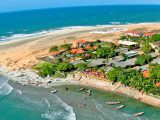
Located in the municipality of Jijoca de Jericoacoara and about 300 km from Fortaleza/CE.
Jericoacoara is a small fishing village with sandy streets without public lighting, a perfect setting for those seeking tranquility, paradisiacal landscapes, excellent gastronomy and an unparalleled astral.
Jericoacoara is no longer the fishing village known only by daring travelers.
Considered one of the most beautiful beaches in Brazil and frequented by tourists from all over the world, Jeri, so called by locals and visitors, has become cosmopolitan.
The dirt roads in Jericoacoara have no street lighting, and the relative isolation – only jeeps or buggies can overcome the dunes that surround it – continues.
Those who get there, however, have the chance to eat in sophisticated restaurants. In the alleys, guides and agencies offer all sorts of tours.
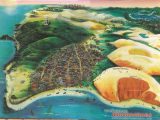
There are tourist signs throughout the village. It takes at least four days to enjoy everything the region has to offer.
With a beach of calm waves and strong winds, Jericoacoara is the perfect destination for windsurfers and kitesurfers.
The long strip of beaten sand, where fishing boats rest, serves for hiking or soccer practice.
In 2002, the village and its surroundings were declared a National Park – in 2007, guardhouses were installed around the park, which, for the time being, only work in high season.
Outside this season, visitation is free, but environmental protection laws are strict.
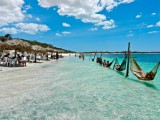
The access is from the city of Jijoca de Jericoacoara, 280 kilometers from Fortaleza, from where buggies, pickup trucks or jardineiras leave, which cover the 23 rugged kilometers that separate them.
Pedra Furada
A walk of just over half an hour along the beach is enough to reach the Pedra Furada, one of the most beautiful postcards of Jericoacoara.
In the corner, the Malhada beach invites you to dive in its calm and warm waters.
The tour must be done at low tide; at high tide, it is necessary to climb steep dunes.
It is also possible to reach the rock by buggy, on a route that passes through the Jijoca lagoon.
Buggy rides
There are two buggy tour options from Jericoacoara.
One of them runs along 12 kilometers of coastline in an easterly direction, and includes Preá beach.
Also visited are 3 kilometers of dunes. The other tour covers 20 kilometers in the west direction of the coast, passing by the beaches of Mangue Seco, Guriú, Tatajuba Velha – a village in ruins about twenty years ago was buried by the sands of the dunes – and Tatajuba Nova, both belonging to the municipality of Camocim.
The two tours last approximately five hours.
DUNA DO PÔR-DO-SOL
Every day, when the afternoon begins to fall, around 5 pm, visitors and locals climb the dune of Jericoacoara to watch the sunset at 40 meters high.
The sun descends until it becomes a large ball over the sea, in a spectacle of shades ranging from violet to orange.
As the sun disappears, the dunes take on yellowish and golden hues and finally turn brown.
At the end, the most enthusiastic applaud; others, more willing, slide down the dune. In high season, capoeira circles provide another good time for visitors.
Bar do Forró
One of Jericoacoara’s traditions, the old Forró do Raimundo has existed for more than 25 years and, so famous, it even gave its name to the street in which it is located – Rua do Forró.
The drag-foot began casually in a space attached to the small family business of the former owner who, without any pretension, put to play his vinyl records on a battery-operated radiola.
That’s all it took for passers-by to start dancing on the sidewalk. Renovated in 2007, it has changed ownership, but still operates in a spacious covered shed, with a large dance floor duly waxed to facilitate the dancers’ performance. Rua do Forró, s/n.
8. City of Bitupitá
The town of Bitupita with 6 thousand inhabitants, Bitupitá is on the border of Ceará with Piauí.
It is a day trip, as it has no infrastructure, it is a rustic fishing village, overlooking a part of the ocean, where several corrals are hidden: labyrinth-shaped traps, made with trunks stuck on the seabed, about 8 meters deep, and covered by a net.
The fish enter the labyrinthine corral and can no longer get out. When the tide goes out, the fishermen take them out, fill their canoes and head for the beach to sell them.
There are about ten corrals near the edge of Bitupitá beach, and others are further away, about 10 kilometers from the coast.
In addition to enjoying the movement of men bringing their livelihood from the sea, you can take advantage of the tour to taste a fresh fish, fried in the few simple stalls on the beach.
The village can be reached by the BR-402 highway from Barroquinha, 40 kilometers from Camocim. From Barroquinha, there is another 35 kilometers of dirt road, recommended only for cars with four-wheel drive.
Tourism and Travel Guide of the West Coast of Ceará



















